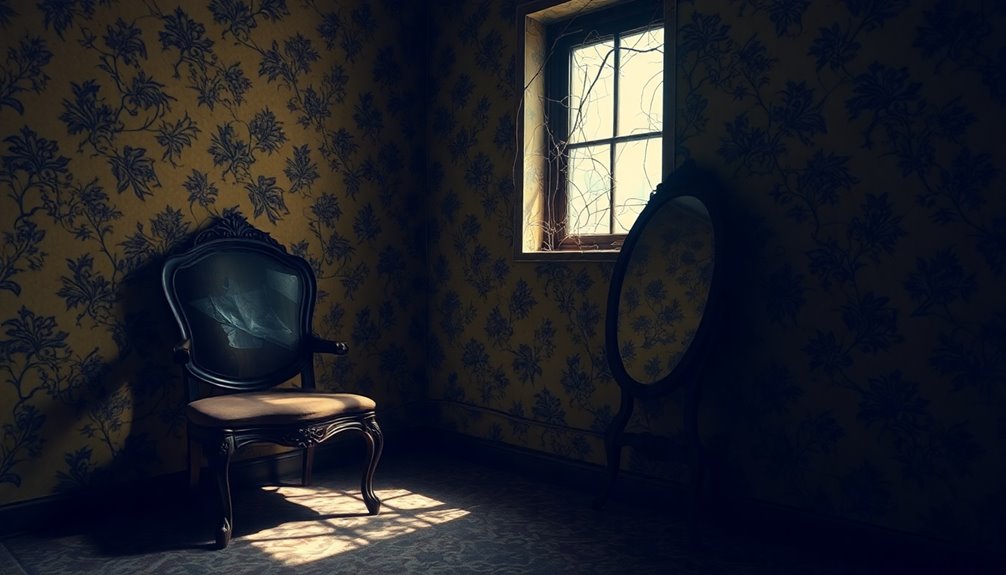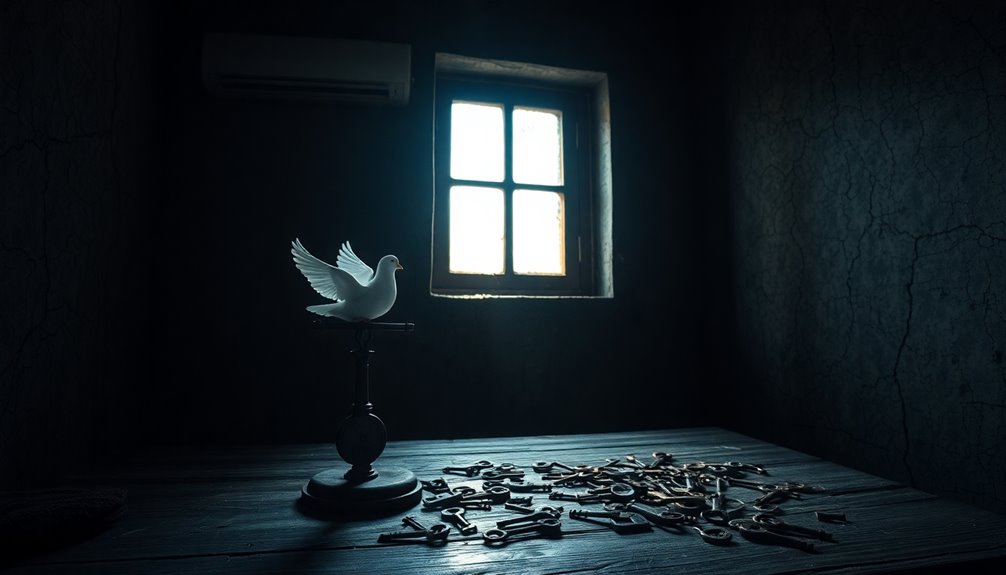The yellow wallpaper in Charlotte Perkins Gilman's story symbolizes the confinement and struggles women face in expressing themselves. It reflects how society often limits women's roles, making them feel trapped. The color yellow changes from joyful to despairing, mirroring the narrator's mental decline. As she grows obsessed with the wallpaper, it becomes a canvas for her suppressed desires. The mysterious figure behind it represents all those hidden feelings. The narrator's diary acts as her secret escape, showing her fight against isolation. It's a fascinating journey of self-discovery, and there's much more to explore about this powerful symbol!
Key Takeaways
- The yellow wallpaper symbolizes the confinement and oppression women faced, reflecting societal norms and expectations regarding their roles.
- The color yellow transitions from joy to despair, mirroring the narrator's deteriorating mental state and loss of individuality.
- The mysterious figure behind the wallpaper represents suppressed desires and the struggle for self-expression among women.
- The wallpaper's deterioration parallels the narrator's psychological decline, illustrating the effects of isolation and lack of agency.
- Ultimately, the wallpaper embodies the clash between creativity and oppression, highlighting the importance of self-identity and autonomy.
Historical Context of the Story

When you plunge into "The Yellow Wallpaper," it's essential to understand the historical context in which it was written. This story, penned by Charlotte Perkins Gilman in 1892, comes from a time when women faced many restrictions. Society expected women to conform to strict domestic life roles, leaving little room for personal expression.
Mental illness was often misunderstood, and the "rest cure," a popular treatment, was commonly prescribed to women. Unfortunately, this treatment often made things worse rather than better.
Charlotte's own experiences with this oppressive rest cure inspired her to write. She felt trapped and silenced, just like the woman in the story. The Yellow Wallpaper itself symbolizes this confinement. As you read, you'll see the connection between the wallpaper's pattern and the struggles women faced for identity and freedom.
Gilman's work serves as an important piece of early feminist literature. It highlights the need for women to reclaim their voice and autonomy. By understanding this context, you'll be able to appreciate the depth of the story and its lasting impact on discussions about mental health and gender equality.
Key Symbols in the Narrative

In "The Yellow Wallpaper," key symbols weave together to reveal the deep struggles of the narrator and, by extension, women of her time. One powerful symbol is the wallpaper itself. It represents the oppressive societal constraints placed on women, reflecting their limited roles in the 19th century. You can almost feel the tension as the intricate patterns mirror the complexities of female entrapment.
Consider these three important symbols:
- The Wallpaper: It shows the narrator's declining mental state, as she becomes more obsessed with its patterns.
- The Woman Trapped Behind: This figure symbolizes the collective struggle of women seeking freedom from societal expectations. She represents those who fight against confinement.
- Tearing Down the Wallpaper: This act symbolizes a desperate quest for liberation and self-identity. It highlights the narrator's rebellion against her isolation.
As the wallpaper deteriorates, so does the narrator's mind, illustrating the connection between her oppressive environment and psychological decline.
These symbols work together, creating a vivid picture of the narrator's fight for freedom and the struggles women faced during that time.
The Role of the Wallpaper
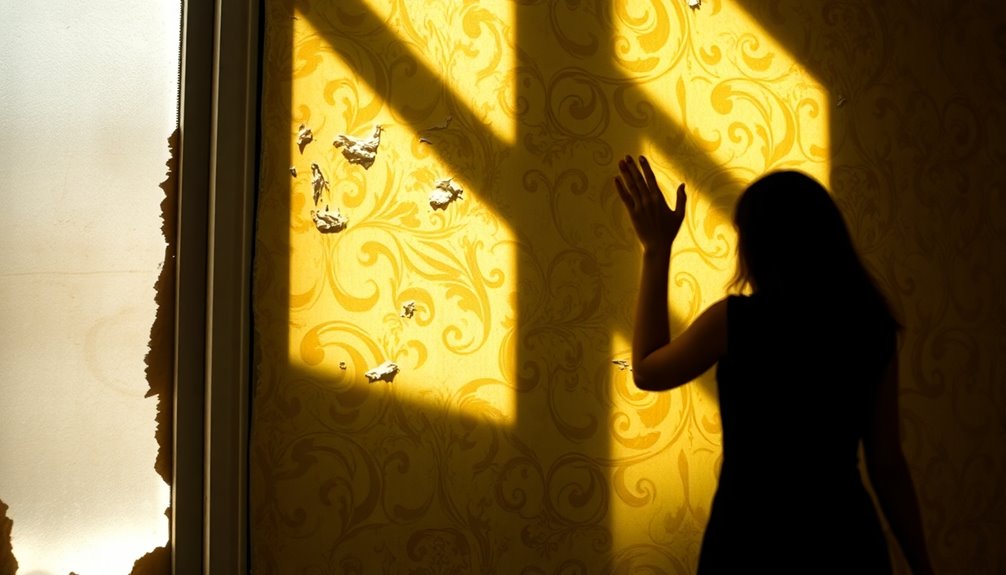
The yellow wallpaper plays a huge role in showing how women felt trapped in the 19th century.
As you read, you'll notice how the patterns reflect the narrator's changing mental state and her longing for freedom.
Oppression and Confinement
Symbolizing the oppression and confinement faced by the narrator, the yellow wallpaper becomes a chilling reflection of 19th-century societal constraints on women. This wallpaper isn't just a decoration; it represents the struggles women endure.
As you explore the story, you'll notice how the wallpaper's intricate patterns mirror the complexities of the narrator's identity and the restrictions placed on her.
Here are three key aspects to reflect upon:
- The Mysterious Figure: The figure trapped behind the wallpaper symbolizes the suppressed desires of women, showing their longing for freedom.
- The Obsession: As the narrator fixates on the wallpaper, it reveals how isolation impacts her mind, highlighting the effects of confinement.
- Tearing it Down: When she tears down the wallpaper, it represents her desperate quest for freedom, a powerful act of rebellion against her circumstances.
Through the wallpaper, you see the narrator's journey from oppression to a desire for autonomy. This symbol serves as a reminder of the struggles many women faced, making it a crucial part of understanding their fight for self-expression and liberation.
Mental State Reflection
As the story unfolds, the yellow wallpaper reflects the narrator's deteriorating mental state, embodying her growing confusion and entrapment. At first, this yellow color seems dull and unattractive, but it soon becomes a symbol of her struggle. The chaotic patterns mirror her declining mental state, illustrating how she's trapped within her own mind.
As she spends more time in her room, the wallpaper turns from just decoration to a focus of obsession. You can almost feel her isolation; she becomes fixated on the strange designs. Each twist and turn of the wallpaper symbolizes the constraints placed on women during the 19th century, paralleling her fight for identity and freedom.
As her mental state worsens, the wallpaper transforms into a prison. It captures her feelings of being trapped within society's expectations.
The climax of the story is thrilling! When she tears down the wallpaper, it represents her desperate attempt to reclaim her autonomy. It's a powerful moment that shows her wish to break free from both physical and mental imprisonment.
The wallpaper serves as a vivid reminder of her journey through confusion and despair, making it an essential part of her story.
Quest for Freedom
Isolating herself within the confines of her room, the narrator's fixation on the yellow wallpaper intensifies her quest for freedom. The wallpaper reflects her struggle against the oppressive constraints of her life.
As you read, you might notice three key ideas:
- Symbol of Entrapment: The yellow wallpaper symbolizes how women were trapped by societal norms in the 19th century. It represents the limits placed on their lives.
- Desire for Escape: As she stares at the wallpaper, her desire for autonomy grows stronger. She sees a figure trapped within it, mirroring her own feelings of confinement.
- Rebellion and Liberation: When she starts tearing down the wallpaper, it becomes a bold act of rebellion. This is her way of fighting against her husband's control and claiming her identity.
Through these actions, the wallpaper transforms from a mere decoration to a powerful symbol of her mental journey.
The narrator's quest for freedom isn't just about escaping a room; it's about breaking free from the chains of oppression. In the end, her struggle shines a light on the importance of self-actualization and the joy of finding one's own path.
The Color Yellow's Significance
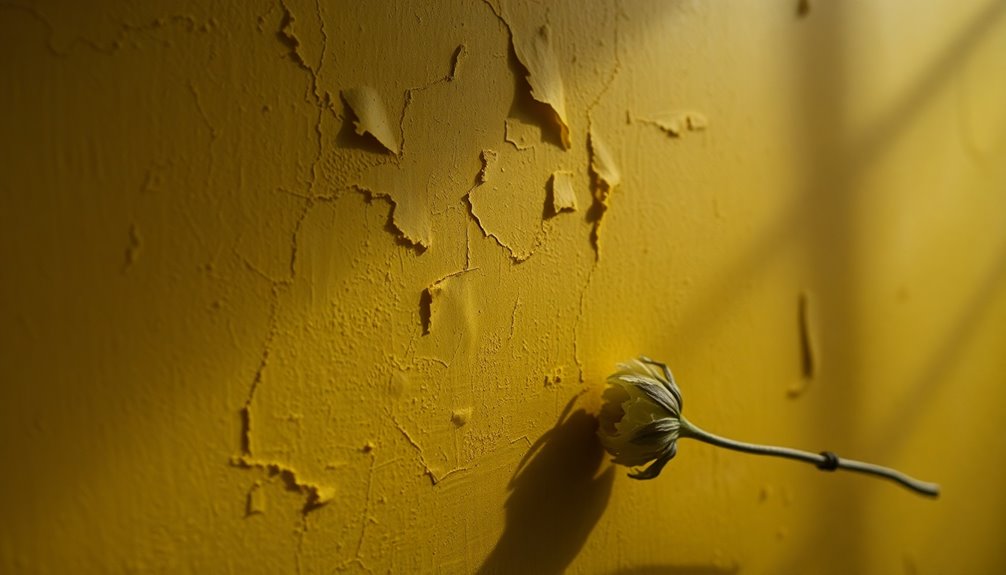
How does the color yellow transform from a symbol of joy to one of despair in "The Yellow Wallpaper"? At first glance, you might think of yellow as bright and cheerful. However, in this story, the color yellow takes on a much darker meaning. The narrator often describes the wallpaper's yellow as a sickly sulphur tint, which makes you feel uneasy. Instead of joy, this color reflects her mental deterioration.
As she spends more time in her oppressive environment, the once-happy yellow becomes a symbol of her struggle. The wallpaper traps her in a world where she feels guilty for not fitting into traditional gender roles. The disconnect between what yellow usually means and her experience shows just how suffocating her situation is.
You can see how her obsession with the wallpaper grows alongside her despair. The color yellow, instead of being a sign of happiness, becomes a reminder of her confinement and emotional turmoil. This transformation highlights the deep struggles women faced during the 19th century, and it encourages you to think about how colors can have very different meanings based on context.
The Narrator's Diary as Resistance
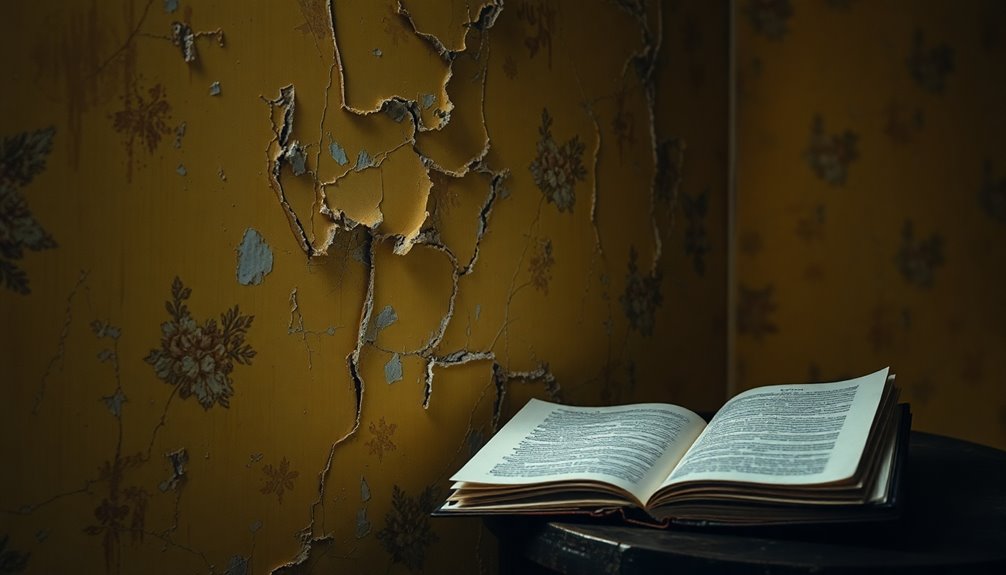
In "The Yellow Wallpaper," the narrator's diary becomes her secret escape.
You see, it's more than just a notebook; it's her way to share her inner thoughts and feelings while fighting against her husband's control.
As she writes, she not only battles her isolation but also searches for her true identity, making her diary a powerful act of resistance.
Expression of Inner Thoughts
The narrator's diary becomes a powerful tool for her self-expression, allowing her to break free from the suffocating silence imposed by her husband and society. Through her writing, she finds a voice in a world that tries to silence her. In her diary, she reveals her inner thoughts, showing how her mind struggles against the confines of her life.
The diary serves as a refuge where she can explore her feelings, and it allows her to:
- Document her experiences, showcasing her mental decline.
- Assert her autonomy, defying her husband's orders to stop writing.
- Reflect on her growing obsession with the wallpaper, which symbolizes her desperate need for identity.
As the narrator becomes more engrossed in her writings, she exposes the truth of her isolation. Each entry helps her confront the constraints placed on her by societal norms and her treatment.
Writing isn't just an act; it's a lifeline. It's where she can express her inner thoughts, fighting against a reality that feels increasingly oppressive. In this way, the diary transforms from mere pages into a vibrant tapestry of her struggle for self-identity and freedom.
Defiance Against Control
Writing in her diary becomes an act of defiance against the stifling control imposed by her husband, John. For the narrator, this diary isn't just a book; it's her secret escape. In a world where she's told what to do and how to feel, the act of writing allows her to express her true thoughts and emotions. Each word she writes battles the isolation that John enforces through his 'rest cure' treatment.
As a woman in a restrictive society, she feels powerless. Yet, her diary symbolizes her fight for freedom. It's a place where she can explore her identity and desires, something denied to her in the outside world. With every entry, she pushes back against the control that tries to define her.
The wallpaper in her room becomes a metaphor for her confinement, while her writing is a way to break free from that prison. The narrator's struggle shows us how important it's for everyone to have a voice. Through her defiance against control, we see the power of self-expression.
Her diary is more than just words; it's a declaration of her spirit and a reminder that every woman deserves to be heard.
Isolation and Identity Seeking
A diary often serves as a refuge for those seeking to understand themselves, and for the narrator of "The Yellow Wallpaper," it becomes an essential means of asserting her identity in a stifling environment. In her isolation, she finds a way to express her thoughts and feelings. Each entry in her diary is a small act of rebellion against the controlling forces around her. It's a lifeline that helps her navigate her mental decline.
Here are three key points about the narrator's diary:
- Self-Expression: The diary allows her to voice her true self, something she can't do in her everyday life.
- Resistance: By writing secretly, she fights against her husband's restrictions and societal norms that limit her.
- Identity: Documenting her experiences helps her explore her identity, showcasing the impact of isolation on her psyche.
As the narrator writes about the wallpaper, she begins to see herself reflected in its patterns. This connection deepens her understanding of her identity, making the diary not just a record but a powerful tool for reclaiming her sense of self.
Themes of Confinement and Oppression
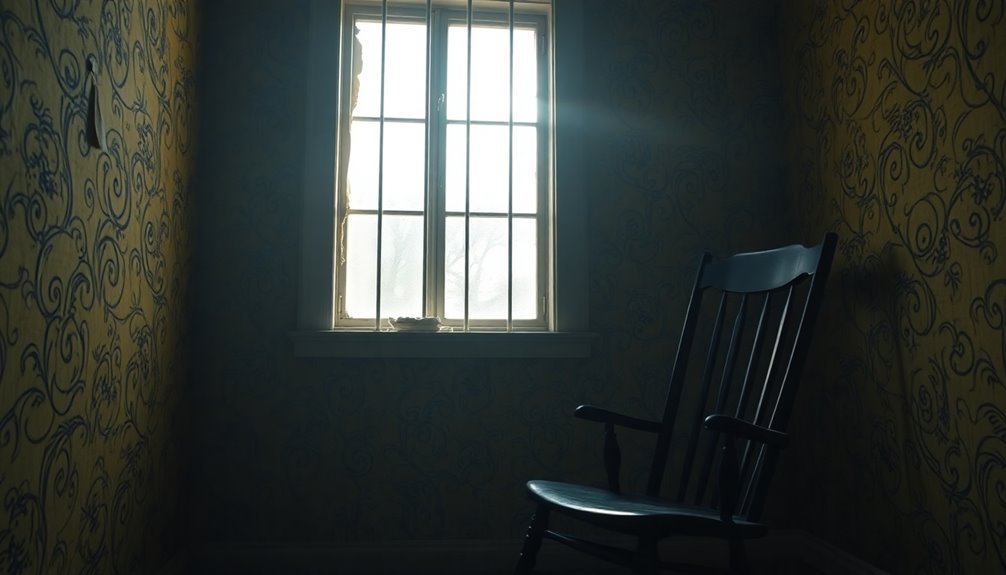
Confinement and oppression permeate the narrative of "The Yellow Wallpaper," illustrating the societal constraints that trap women within rigid roles. In the story, the room where the narrator is confined symbolizes the limitations imposed by her marriage and the oppressive treatment she faces.
You can feel the weight of her isolation as she struggles with her identity. The narrator sees a figure trapped behind the wallpaper, and this figure represents her own feelings of entrapment. It reflects the broader repression faced by women in the 19th century.
As her mental state deteriorates, the wallpaper becomes a canvas for her fight for self-identity and autonomy. The oppressive environment around her highlights how isolation affects her mind.
The confinement she experiences mirrors the societal restrictions on women's freedom and expression. You can sense the conflict between her reality and perception, which emphasizes the negative effects of such repression on mental health.
The Dynamics of Gender Roles

Within the confines of the nursery, the narrator's experience starkly illustrates the dynamics of gender roles in the 19th century. You can see how her life is shaped by strict expectations. These limitations affect her autonomy and sense of self.
- Confinement: The nursery, like a cage, restricts her freedom. She's treated as fragile and incapable, which reflects society's view of women.
- Oppression: John's authoritative behavior shows how men dominated households. He dismisses her feelings, believing he knows what's best for her.
- Rebellion: As she becomes obsessed with the wallpaper, it symbolizes her struggle. Tearing it down becomes an act of rebellion, representing her fight against those oppressive gender roles.
This story critiques how society views domesticity as a woman's only role, trapping her in a cycle of oppression.
As the narrator battles against these constraints, you can sense her desperation to reclaim her identity and freedom. Her journey reflects the struggle many women faced, pushing against the walls of societal expectations.
Through her experiences, you witness the importance of autonomy and the need for women to break free from their confines, seeking joy and self-discovery.
Psychological Deterioration and Identity
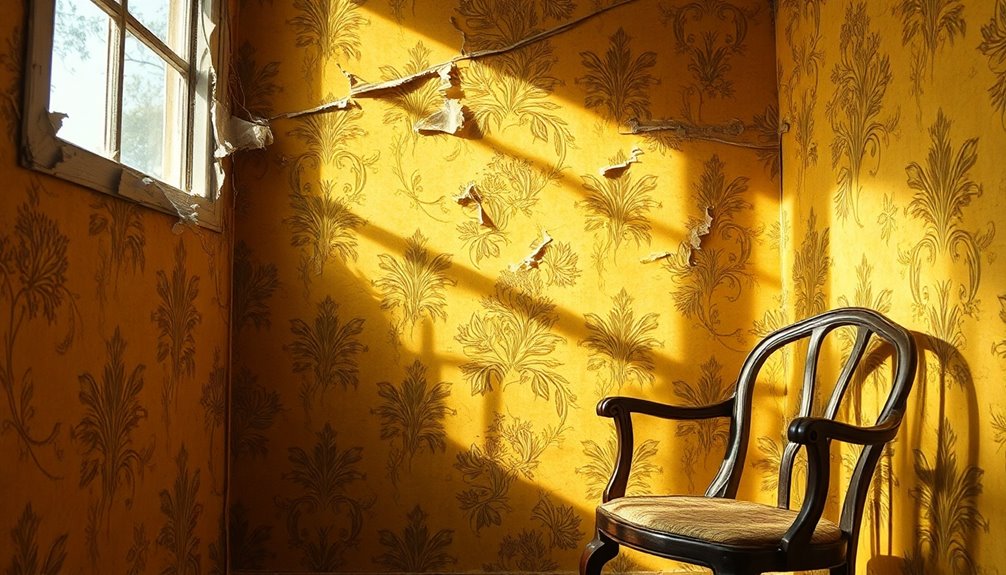
As the narrator's isolation deepens, her psychological deterioration becomes increasingly apparent, reflected in her obsession with the yellow wallpaper. At first, she finds the wallpaper ugly and confusing, but as time goes on, its chaotic patterns start to mirror her own troubled mind. You can see her identity slowly breaking apart, just like the wallpaper itself.
As she spends more time in the room, her fixation grows stronger. She feels trapped by her surroundings and struggles to understand who she really is. This female narrator battles societal expectations, and the wallpaper becomes a symbol of her fight for self-identity.
When she finally tears down the wallpaper, it's a powerful moment. This act represents her desperate attempt to reclaim her identity and escape the psychological confinement imposed by her husband and society.
The wallpaper shows how her mental health suffers under isolation and repression. In this way, the yellow wallpaper highlights the connection between her psychological deterioration and her quest for identity.
It reminds us that sometimes, breaking free is the only way to rediscover ourselves.
The Impact of the Rest Cure

The rest cure, a widely accepted treatment for women's mental health issues in the 19th century, profoundly impacts the narrator in "The Yellow Wallpaper." Designed to enforce isolation and inactivity, this approach stifles her creativity and intellectual engagement, ultimately worsening her mental health. Instead of helping her, the rest cure traps her in a cycle of despair.
Here are three key effects of the rest cure on the narrator:
- Isolation: The narrator is confined to a room, cut off from the outside world. This loneliness leads her to feel even more trapped and misunderstood.
- Suppression of Creativity: With the ban on writing and other activities, she can't express herself. Her ideas and thoughts swirl in her mind, creating frustration instead of clarity.
- Deteriorating Mental Health: As her isolation continues, her mental state declines. The rest cure, meant to heal, becomes a catalyst for her growing madness.
Ultimately, the rest cure reflects how society viewed women as fragile beings in need of control. Through the narrator's experience, we see how this oppressive treatment only deepens her sense of entrapment.
Frequently Asked Questions
What Is the Symbol of the Wallpaper in the Yellow Wallpaper?
The wallpaper in the story represents many things!
It reflects the feelings of being trapped and confined, just like the main character. As you see her struggle, the wallpaper's patterns symbolize her growing madness.
When she tears it down, it's like she's fighting for her freedom!
The figure she sees in the wallpaper shows how women often feel stuck in roles and want to break free and express themselves.
It's a powerful symbol!
What Does the Illness Symbolize in the Yellow Wallpaper?
The illness in "The Yellow Wallpaper" is like a giant monster, trapping the narrator in a cage of societal expectations!
It symbolizes how society restricts women, making them feel powerless. As the narrator struggles with her mental health, you see how isolation and lack of freedom can twist a person's mind.
Her journey shows the pain women faced back then, fighting for their voices and identities in a world that often silenced them.
What Does the Baby Symbolize in the Yellow Wallpaper?
In "The Yellow Wallpaper," the baby symbolizes the narrator's lost connection to motherhood and her desire for freedom.
It shows how society expects women to be caring and submissive. The baby's absence reflects her emotional struggles and isolation, making her feel trapped.
As she obsesses over the wallpaper, she identifies with a figure caught inside it, mirroring her own feelings of confinement.
This adds depth to her journey and highlights her mental challenges.
What Does John Symbolize in the Yellow Wallpaper?
John symbolizes the strict control and dismissive attitudes men often had towards women, especially in the past.
Imagine a teacher who never listens to their students' ideas and just talks over them. That's like John! He represents the way society ignored women's feelings and needs.
Conclusion
In the end, "The Yellow Wallpaper" isn't just a story about a room; it's a powerful look at how confinement can trap the mind. Just like the brave Alice in Wonderland, who explores her own curious world, the narrator seeks freedom in her imagination. The wallpaper, with its tangled patterns, represents the struggles many face in a world that often limits them. By understanding her journey, we can find joy in our own stories and the freedom to express ourselves!

